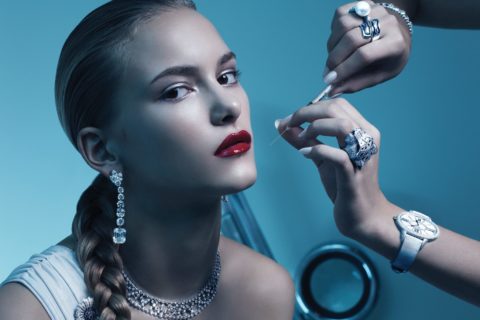Why Cosmetic Injectables Are Giving Your Lower Face a Lift
The controversy surrounding Bethenny Frankel’s turn on Bravo’s top-rated Real Housewives of New York City isn’t limited to the show’s latest scandals and shenanigans. The recent change in Frankel’s face sparked speculation that she’d gone under the knife, but the Skinnygirl Cocktails mogul credits Botox injections for her jawline’s softer, slimmer contours.
While it used to be considered dicey to inject Botox in the lower face (it paralyzes muscles, after all), this new placement is just one example of how doctors are getting more strategic in their approach to injectables, moving beyond the idea of “freeze or fill” and directing their needles farther south. “Rather than looking at separate anatomical areas, we’re now using Botox and fillers to really sculpt the face overall for a younger look,” says Dr. Jamil Asaria, a Toronto facial plastic surgeon. Office visits that were once about plumping folds or eliminating scowly “11s” between the brows are now a meditation on reshaping. “There are more choices of injectables from manufacturers, and we’re being more creative in how we use them, pushing the products to the safest limits,” adds Dr. Michael Weinberg, a plastic surgeon based in Mississauga, Ont., who notes that most lower-face uses of Botox are still off-label.
As in Frankel’s case, the changes can be dramatic and seemingly the type that only a facelift could provide. That’s because the jaw tends to look wider and boxier over time due to descending volume and overactive masseter (chewing) muscles. “The technique of using Botox in the jaw originated in Korea, because Koreans typically have a wide, square jaw and it’s more feminizing to have a softer ‘V’ shape,” says Dr. Frank Lista, a Toronto plastic surgeon. “Here, we call it the ‘inverted triangle of youth.’” Injecting 20 to 30 units of Botox per side, right where the muscle meets the jawline and contracts, can recontour the face as the jaw gradually narrows. Expect to wait a month or more for the muscles to shrink, and know that it may take more than one treatment before you see the lifting effect.
Another way to recapture that youthful V shape? Filler. “We’re not doing chin implants so much anymore,” says Weinberg. “Now we’re using a stiffer, more cross-linked hyaluronic-acid (HA) filler, like Voluma or Perlane, injected right on the bone of the chin to recreate that heart shape or inverted triangle.” For jawlines that become less defined with age, resulting in jowls, filler is the go-to as well. “If you hold a finger on the corner of your mouth across to your jaw and imagine a clothesline, it’s like gravity has caused the clothes on it to get heavy and droop,” explains Weinberg. “Rather than lift and redrape as with surgery, we can disguise that descent with filler, smoothing out the valley.”
According to Asaria, this collapsing along the chin and jaw is one of plastic surgery’s hottest topics right now. “At a recent conference, we spent three hours talking about how to support the chin to help mask the jowls and marionette lines, because a defined jawline is very youthful, too—think of Olivia Wilde or Angelina Jolie,” he says. (Voluma is the treatment of choice among these docs to bolster and support.) Excessive chin dimpling—nearly as undesirable as the leg-and-butt variety—often adds insult to injury when it comes to jowls. “It’s a common problem,” says Lista. “It can look sort of like orange peel when you’re talking or eating. Patients often think nothing can be done about it, but if we inject just a couple of units of Botox in the area, it can make it go away. Patients think it’s a miracle.” Botox also comes in handy for similar over activity in the neck muscles, which loosen over time and may appear to clench. “We inject a small amount directly into the platysmal bands, which run vertically from the chin to the collarbone, to get rid of that ropy look,” says Weinberg, who often treats patients in their 40s hoping to head off the dreaded wattle.
Treating the lower face may be the biggest news, but the mid-to-upper face is getting a revamp, too, with Botox and filler often working best in tandem. (Weinberg likens them to salt and pepper: one relaxes the muscles; the other shapes and contours.) Asaria injects five units of Botox at the outer corner of the brow to relax the muscle that pulls it down. The result is an instant eye lift. “The tail of the eyebrow should always be a bit higher than the middle part in women,” he says. “I’ve even done this on a 25-year-old model. A lot of my clients are models and actresses, and everyone’s on Instagram these days. Their faces are their livelihood, so subtle, natural-looking changes like this can make a big difference.” And if age or your running habit has hollowed your temples, filler can restore a more natural, eye-pleasing curve. “The eye likes to see oval shapes,” adds Asaria. “Depressions, concavities and shadows are what create an aged appearance.” Injecting the temples won’t, however, significantly lift the nasolabial folds, and injecting the folds themselves (ironically the original target of fillers) tends to disappoint and sometimes distort the face. The more modern way to get that lift sans surgery? Injecting the apex of the cheek. “The reason the nasolabial folds look more obvious with age is due to loss of support in the cheeks,” says Asaria. “I often start my treatment plan by injecting the upper cheek, the apex and a little to the side of the eye to restore some fullness and structure.”
The key, of course, is to get that placement just right—not only for aesthetics but also to avoid becoming a cautionary tale. HA fillers can be dissolved with an injection of hyaluronidase, but you may have to live with Botox gone wrong for six to nine months. “If you overdo it in the forehead, it’s not a huge deal,” says Lista. “But if you interfere with the muscles of the mouth so that it doesn’t work right, it can be a disaster.” In other words, a skilled injector who understands the anatomy of the face and works conservatively is a necessity. “It’s about less is more,” says Asaria. “We’re using less product but treating more areas. When done right, it’s a non-surgical facelift.”








